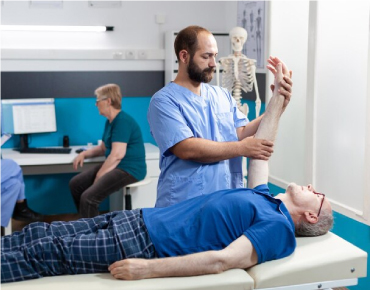- Home
- Blog Details
Enhancing Quality of Life: The Vital Role of Physiotherapy in Palliative Care
 24 September, 2023
24 September, 2023
Understanding Lymphoedema & Mgt with Physio
Lymphoedema is a common yet often misunderstood condition that affects approximately one in every 200 people. It can occur as a side effect of cancer treatment or due to other underlying health issues. Despite its prevalence, many healthcare professionals lack knowledge about this condition. In this article, we'll shed light on lymphoedema, its causes, prevention, and available treatments.
What is Lymphoedema?
Lymphoedema is characterized by the buildup of protein-rich fluid, leading to swelling in various parts of the body, commonly the limbs. It can also affect the trunk, breasts, head, neck, or genitals. Unlike its historical classification as a skin condition, lymphoedema is primarily related to the lymphatic system, a network of vessels and nodes beneath the skin.
Causes of Lymphoedema:
Lymphoedema can be categorized as either primary or secondary:
- Primary Lymphoedema: This is a rare congenital condition where lymphatic vessels don't develop properly. It can affect the lower limbs and may have a genetic link.
- Secondary Lymphoedema: Often triggered by surgery, infections, cancer-related lymph node removal, or other obstructions, secondary lymphoedema is more common. Breast cancer surgery, in particular, can lead to secondary lymphoedema.
Preventing Lymphoedema:
Prevention is key when it comes to lymphoedema. If you're at risk, follow these guidelines:
Do's:
- Keep the affected limb clean and moisturized.
- Stay mobile and maintain a healthy weight.
- Wear gloves while gardening and doing housework.
- Protect yourself from extreme temperatures and sunburn.
- Avoid mosquito bites with repellent and appropriate clothing.
- Be cautious during long flights; consider compression garments.
Don'ts:
- Avoid needles, injections, or blood pressure measurements on the affected limb.
- Refrain from getting tattoos on the affected area.
- Limit repetitive heavy activities with the affected limb.
- Avoid significant weight gain.
- Don't wear tight clothing or accessories that restrict lymphatic flow.
Diagnosis and Staging:
Early warning signs of lymphoedema include heaviness, tightness, and puffiness. Diagnosis typically involves an observational assessment by a qualified healthcare professional. Lymphoedema stages range from subclinical (no visible swelling) to severe (significant skin changes).
Physiotherapy Treatment:
- Education is essential, emphasizing the progressive nature of lymphoedema.
- Compression techniques, including bandaging, garments, wraps, and intermittent pneumatic compression, can help reduce limb volume.
- Manual Lymphatic Drainage (MLD) and Self Lymphatic Drainage (SLD) techniques may be used.
- Skincare is crucial to prevent infections and maintain skin health.
- Exercise, guided by a physiotherapist, aids in lymphatic return and muscle pump support.
- Other treatment modalities like Low-Level Laser Therapy and Kinesio taping may be considered.
- Surgical interventions, such as Lymph Node Transfer, Lymphovenous Anastomosis (LVA), Liposuction, or Debulking, are considered in advanced cases.
Conclusion: Lymphoedema is a condition that can significantly impact one's quality of life, but with proper education, prevention, and treatment, its effects can be managed. It's essential to raise awareness about lymphoedema, both among healthcare professionals and the general public, to ensure timely diagnosis and access to appropriate care. If you suspect you have lymphoedema or are at risk, seek guidance from a qualified healthcare provider for personalized support and treatment.
Let's work together to make a difference in healthcare and earn not only money but also the blessings of those we help. Thank you for your attention to this critical aspect of healthcare.

Christine Eve
Lorem ipsum is simply free text used by copytyping refreshing. Neque porro est qui dolorem ipsum quia quaed veritatis et quasi architecto.







